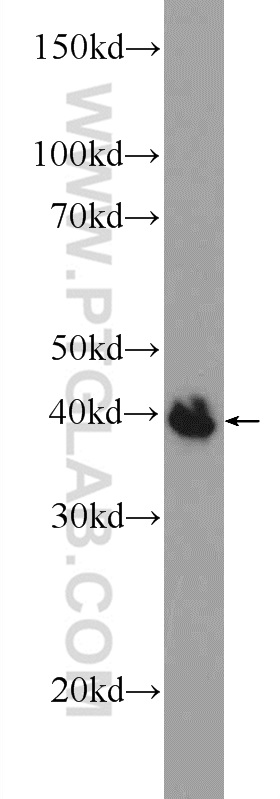验证数据展示
经过测试的应用
| Positive WB detected in | fetal human brain tissue |
推荐稀释比
| 应用 | 推荐稀释比 |
|---|---|
| Western Blot (WB) | WB : 1:200-1:1000 |
| It is recommended that this reagent should be titrated in each testing system to obtain optimal results. | |
| Sample-dependent, Check data in validation data gallery. | |
发表文章中的应用
| IF | See 1 publications below |
产品信息
25114-1-AP targets POU3F4 in WB, IF, ELISA applications and shows reactivity with human, mouse samples.
| 经测试应用 | WB, ELISA Application Description |
| 文献引用应用 | IF |
| 经测试反应性 | human, mouse |
| 文献引用反应性 | mouse |
| 免疫原 | POU3F4 fusion protein Ag18925 种属同源性预测 |
| 宿主/亚型 | Rabbit / IgG |
| 抗体类别 | Polyclonal |
| 产品类型 | Antibody |
| 全称 | POU class 3 homeobox 4 |
| 别名 | BRAIN 4, Brn 4, BRN4, DFN3, DFNX2, Oct 9, Octamer binding protein 9, OTF 9, OTF9, POU class 3 homeobox 4, POU3F4 |
| 计算分子量 | 361 aa, 39 kDa |
| 观测分子量 | 40-45 kDa |
| GenBank蛋白编号 | BC146551 |
| 基因名称 | POU3F4 |
| Gene ID (NCBI) | 5456 |
| RRID | AB_2879903 |
| 偶联类型 | Unconjugated |
| 形式 | Liquid |
| 纯化方式 | Antigen affinity purification |
| UNIPROT ID | P49335 |
| 储存缓冲液 | PBS with 0.02% sodium azide and 50% glycerol pH 7.3. |
| 储存条件 | Store at -20°C. Stable for one year after shipment. Aliquoting is unnecessary for -20oC storage. |
背景介绍
OTF9 also named as BRN4 and POU3F4, belongs to the POU transcription factor family and Class-3 subfamily. OTF9 is a transcription factor which exerts its primary action widely during early neural development and in a very limited set of neurons in the mature brain. Mutation of OTF9 will cause of X-linked deafness type 3 (DFN3).
实验方案
| Product Specific Protocols | |
|---|---|
| WB protocol for POU3F4 antibody 25114-1-AP | Download protocol |
| Standard Protocols | |
|---|---|
| Click here to view our Standard Protocols |
